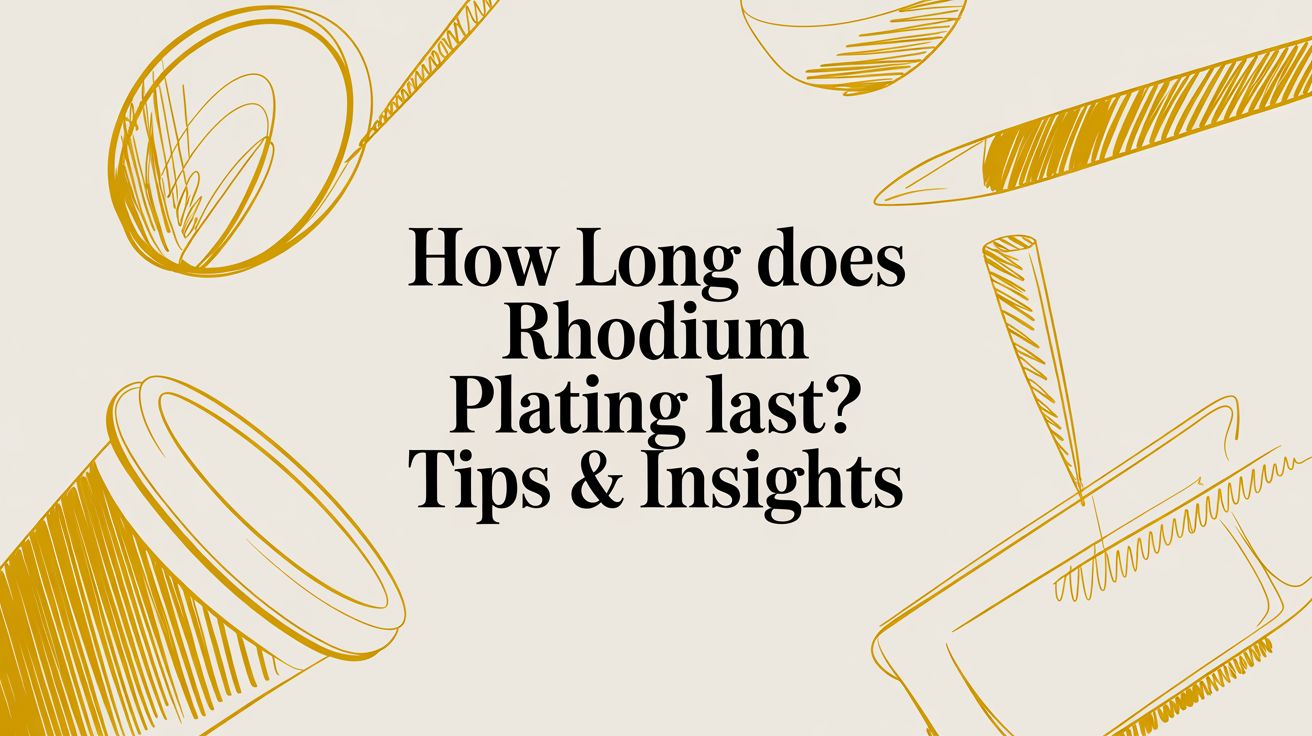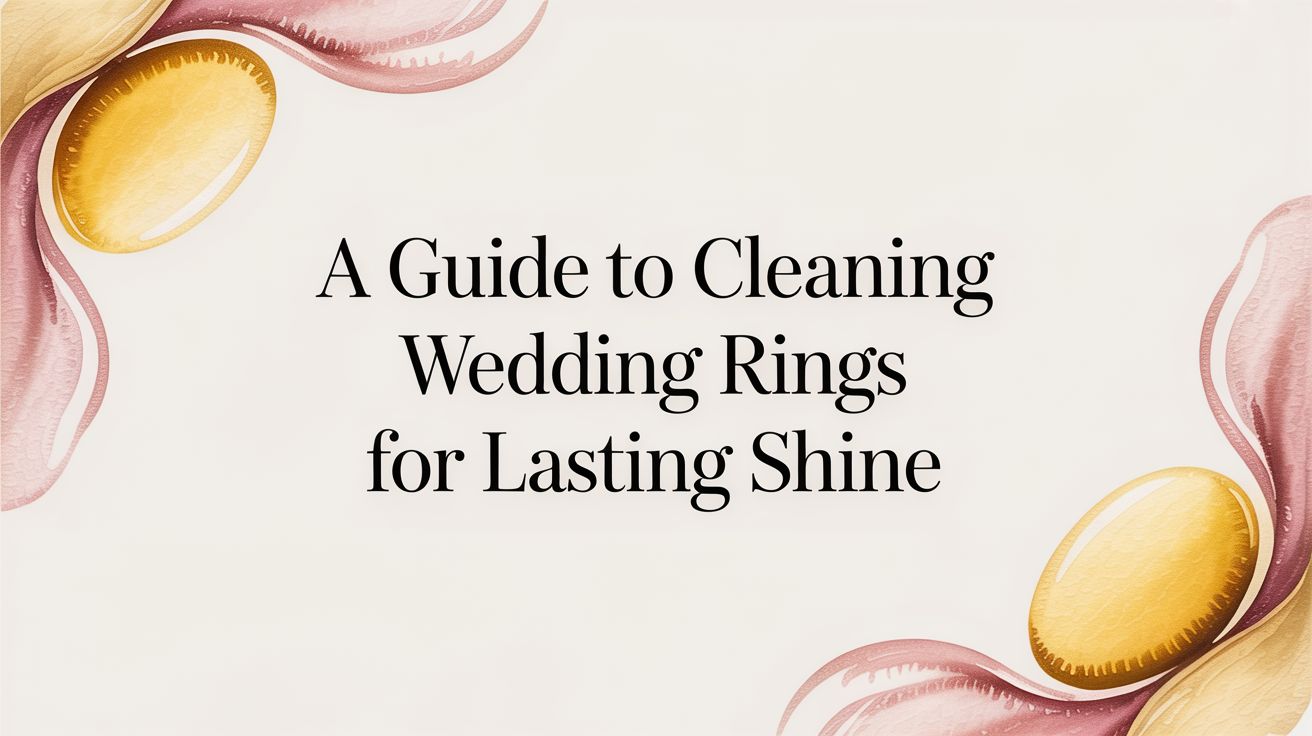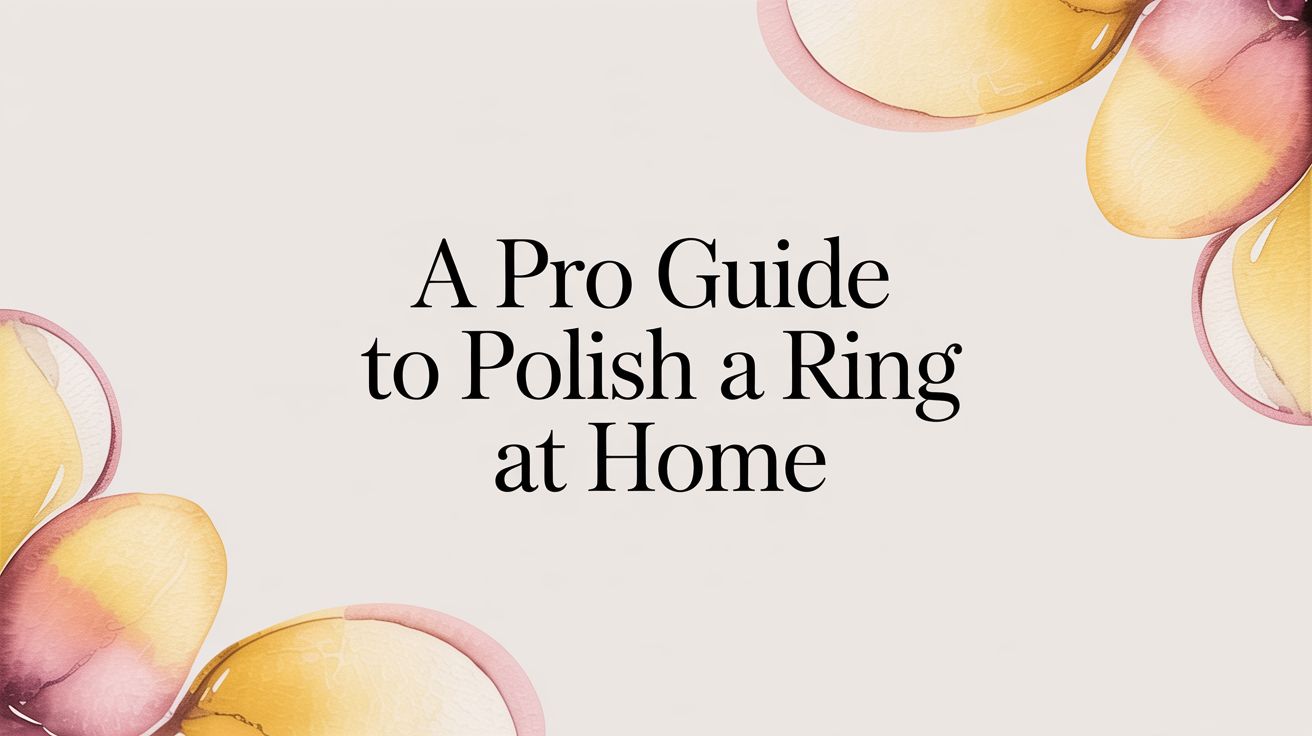For jewellery you wear all the time, like an engagement ring, a good rhodium plating will typically last between 6 and 18 months. But for pieces that don't see as much action—think earrings or pendants—that protective shine can last for years before needing a top-up.
What Exactly Is Rhodium Plating?
Think of rhodium plating as a suit of shining armour for your favourite jewellery. It’s a micro-thin layer of rhodium—a rare, precious metal from the platinum family—that we apply over metals like white gold or silver through a process called electroplating. This isn't just for looks; it serves a crucial purpose.
Most "white gold," for instance, isn't naturally a brilliant, crisp white. It has a faint yellowish tint because of the gold alloys used to make it. Rhodium plating is the industry’s secret weapon, giving it that stunning, mirror-like finish everyone loves. The process boosts the jewellery's appearance and adds a tough, scratch-resistant shield that keeps tarnish at bay.
Key Benefits of Rhodium Plating
This protective layer does more than just make your jewellery look good. Here are the main advantages:
- Enhanced Durability: It provides a hard, protective barrier against the everyday scratches and scuffs that dull your jewellery.
- Brilliant Appearance: It gives white gold and silver that coveted, ultra-white, reflective shine that makes diamonds pop.
- Hypoallergenic Properties: Rhodium is nickel-free, creating a safe barrier for anyone with sensitive skin who might react to the alloys in the base metal.
The picture below shows just how dramatic the difference is, transforming a standard white gold ring into a brilliant, mirror-finished piece.
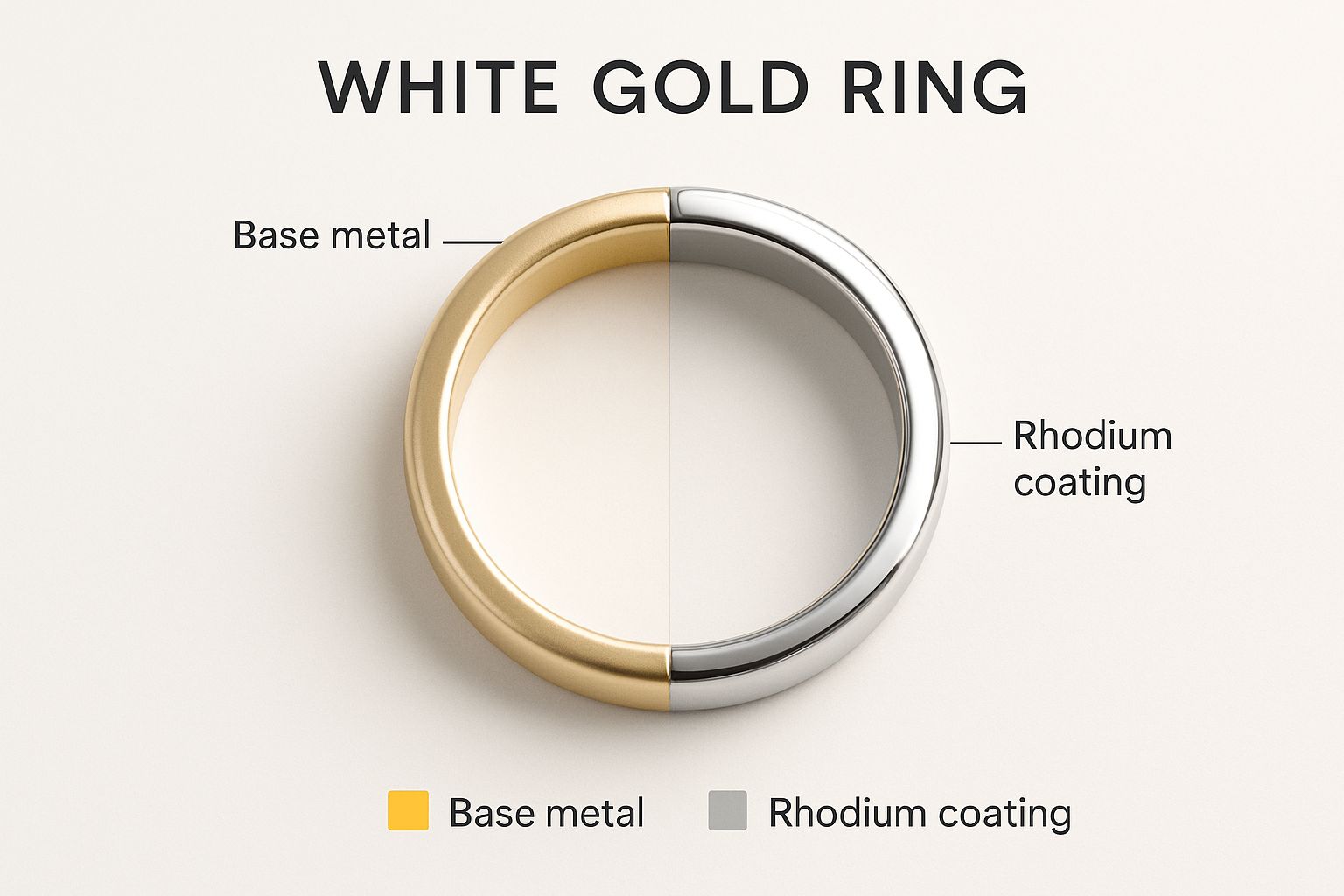
You can really see how the plating completely masks the warmer, yellowish tones of the base metal, resulting in that crisp, clean white look that's so sought-after in modern jewellery.
How Long Should You Expect Rhodium Plating to Last?
So, how long does that brilliant, mirror-like shine actually stick around?
For a piece you wear every day, like an engagement ring, you can generally expect the rhodium plating to last between 6 and 18 months. It's a beautiful but very thin layer, so it needs a bit of upkeep to keep it looking flawless.
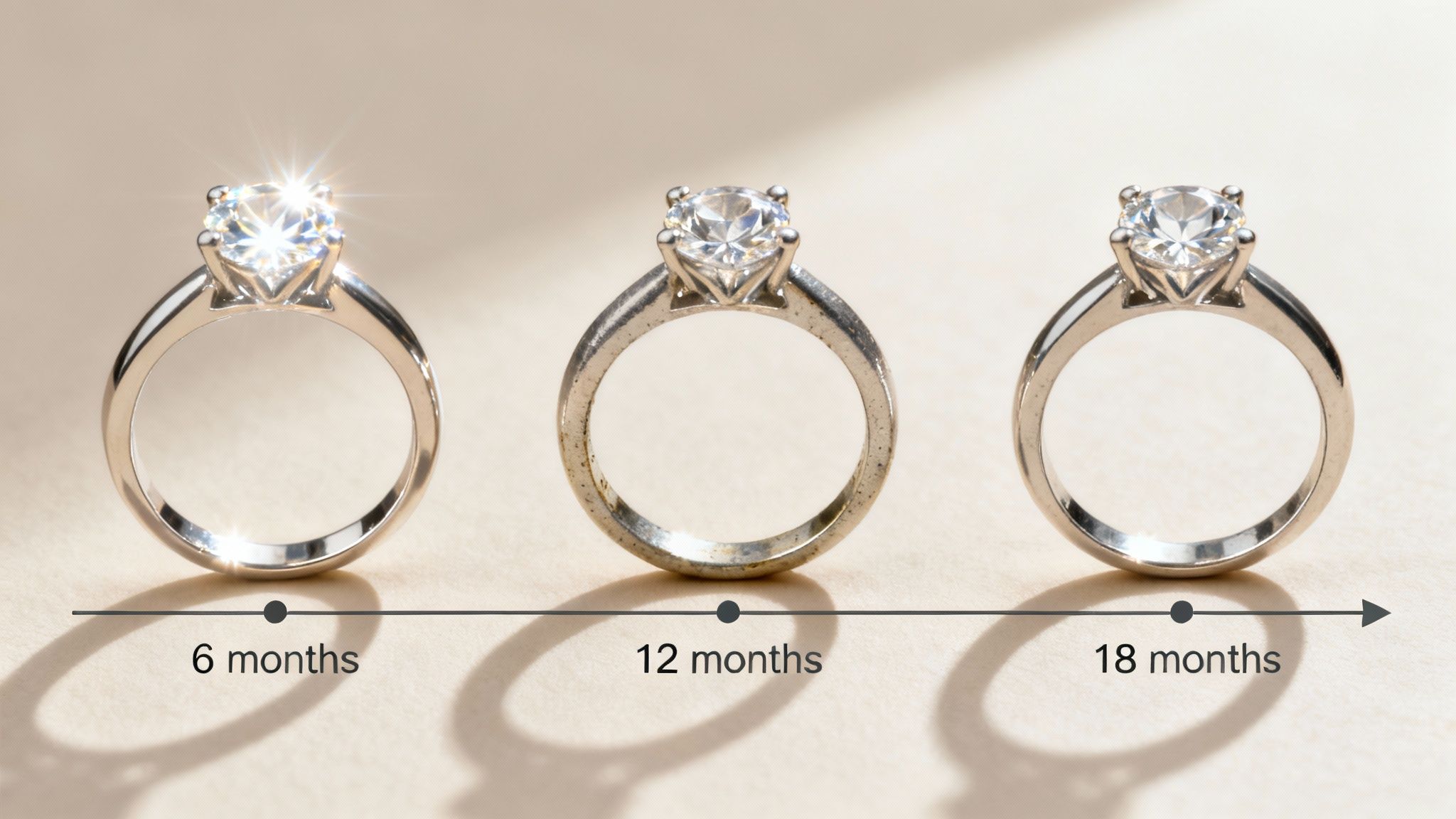
The lifespan really comes down to one thing: how you wear your jewellery. A ring that’s constantly rubbing against things will need replating far sooner than a pair of earrings that rarely get touched. The standard plating thickness is just 0.75 to 1.5 microns—that's thinner than a single strand of silk—so it naturally wears away with contact over time.
In the UK, it’s a good rule of thumb to expect a wedding or engagement ring to need a fresh coat of rhodium about once a year. Think about it: it’s exposed to everything—your skin's natural oils, hand lotions, household cleaners, and just general friction. To learn more about looking after your jewellery, it’s always worth checking with UK jewellery specialists on maintaining white gold.
Estimated Rhodium Plating Lifespan by Jewelry Type
Of course, not all jewellery lives the same life. A bracelet is going to see a lot more action than a pendant. Knowing the difference helps you set realistic expectations for your own pieces.
This table gives a clearer picture of what to expect based on how much contact each item typically gets.
| Jewelry Type | Frequency of Wear | Estimated Lifespan | Common Wear Factors |
|---|---|---|---|
| Rings | Daily | 6–18 months | Constant friction, hand soaps, lotions, skin oils. |
| Bracelets | Frequent | 1–2 years | Rubbing on desks, clothing, and other surfaces. |
| Necklaces | Occasional Contact | 2+ years | Minor contact with skin and clothing. |
| Earrings | Minimal Contact | Often indefinitely | Very little friction; protected from most wear. |
As you can see, rings are always the first to show wear simply because our hands are always busy. Earrings, on the other hand, can hold their rhodium finish for years without any trouble.
What Makes Rhodium Plating Wear Off Faster?
Ever wondered why your friend’s ring looks pristine for two years, but yours needs a touch-up every six months? It’s not just about time. The lifespan of your rhodium finish really comes down to what it’s exposed to every day.
Think of it like a countdown timer. The main things that speed up that timer are your personal habits, your environment, and even the design of the jewellery itself. Knowing what they are is the key to making that brilliant finish last.
Your Personal Chemistry and Habits
Believe it or not, your own body can be a factor. Everyone’s skin has a unique pH level, and if yours is on the more acidic side, it can slowly eat away at the rhodium layer.
But what you put on your skin often matters even more. These are the most common culprits for speeding up wear and tear:
- Lotions and Creams: Thick hand creams don’t just moisturise; they create friction and contain chemicals that can break down the plating.
- Perfumes and Hairsprays: The alcohol and other chemicals in these sprays are surprisingly harsh on precious metal finishes.
- Hand Sanitisers: With their high alcohol content, sanitisers are particularly aggressive and can strip plating with frequent use.
A great rule to live by: make your jewellery the last thing you put on and the first thing you take off. This simple habit keeps it away from direct contact with all those corrosive products.
Environmental and External Factors
Your surroundings play a huge part, too. That micro-thin layer of rhodium is vulnerable to all sorts of abrasion and chemicals you might not even think about. Something as simple as typing on a keyboard or gripping a steering wheel will constantly rub away at the plating on the bottom of a ring.
Other aggressors in your environment include:
- Chlorine: Found in swimming pools and hot tubs, chlorine is one of the fastest ways to damage and discolour rhodium.
- Abrasive Cleaners: Household products with bleach or other harsh chemicals are a definite no-go when you’re wearing your jewellery.
- Salty Air: Even living near the coast can have a subtle, long-term corrosive effect from the salt in the air and water.
Finally, the very design of your jewellery makes a difference. A ring with sharp edges, intricate details, or high-set claws will naturally lose its plating on those high-contact points much faster than a simple, smooth band. Of course, expert jewellery maintenance can restore that beautiful finish, no matter the design.
Signs Your Jewellery Needs Replating
Knowing when it's time to visit your jeweller is the key to keeping your favourite pieces looking pristine. The good news is your jewellery will give you clear visual hints when its protective rhodium layer is wearing thin, long before any harm comes to the metal underneath.
The most obvious sign is a change in colour. You might start to see a warm, yellowish tint peeking through, especially on areas that get a lot of contact. This isn’t damage—it’s just the natural, slightly yellow hue of the white gold base showing itself as the brilliant white rhodium wears away.
Where to Look for Early Signs
Wear and tear is never even. The first places to check are always the points of highest friction.
- On Rings: Take a look at the bottom of the band (what we call the shank) and the edges or claws holding the stone. These parts are constantly rubbing against skin, desks, and steering wheels.
- On Bracelets: Check the clasp and the links that rest against your wrist. These are the areas that see the most action day-to-day.
Another dead giveaway is a loss of that crisp, mirror-like shine. If your piece starts to look a bit dull or lacks its original bright reflection, the rhodium is likely on its way out. A great little trick is to compare a high-wear area, like the bottom of a ring, to a more protected spot, like the inside of the band.
If you can see a clear colour difference between the protected and exposed parts of your jewellery, that's a sure sign it's time for a replate. Catching it early stops the underlying gold from getting scratched.
By keeping an eye out for these signs, you can get its original brilliance back with a quick trip to the jeweller, keeping it looking brand new for years to come.
Simple Ways to Extend Your Plating's Lifespan
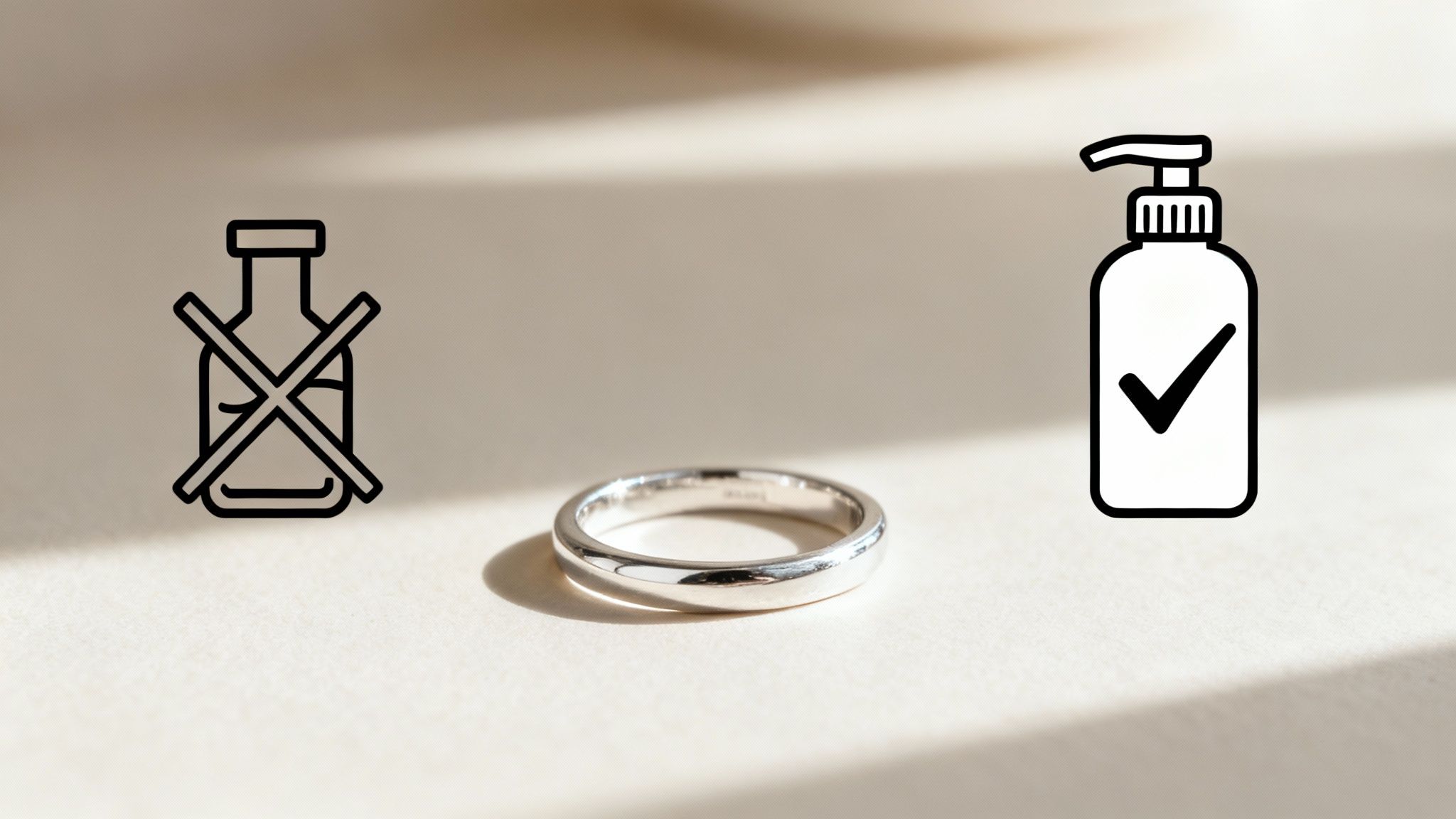
You can seriously prolong the time between replating appointments with a few simple habits. A bit of protective care will keep your jewellery shining brighter for much longer, saving you both time and money.
The golden rule? Your jewellery should be the last thing you put on before you go out and the first thing you take off when you get home. It’s the easiest way to minimise contact with things that can damage the finish.
Best Practices for Daily Care
To get the most out of your rhodium plating, a few small daily adjustments make a world of difference. Think of them as building a protective barrier against premature wear.
- Remove Before Activities: Always take your rings off before swimming, cleaning, or heading to the gym. Chlorine is particularly harsh, and the friction from lifting weights can strip the plating surprisingly quickly.
- Apply Products First: Let your lotions, perfumes, and hairsprays dry completely before you put your jewellery on. The chemicals and alcohols in these products will gradually degrade the rhodium.
- Gentle Cleaning Only: For cleaning, all you need is a mild soap and warm water solution with a very soft cloth. Never use abrasive materials like toothpaste or stiff brushes—they’ll scratch and strip the plating.
A common mistake we see is wearing plated rings while doing household chores. The harsh chemicals in cleaning products will wear down your rhodium plating in no time.
What to Avoid at All Costs
Knowing what not to do is just as important. Some habits can wear away a rhodium layer in a fraction of its normal lifespan, forcing you into frequent and unnecessary replating.
Steer clear of at-home ultrasonic cleaners unless you are absolutely certain they are safe for plated items. You should also avoid any polishing cloths treated with abrasive compounds. If your piece looks dull and a gentle wash isn't helping, it’s a sign it needs a professional eye. Expert jewellery polishing can safely restore its shine without harming the metal underneath.
The Replating Process and Typical UK Costs
So, how do we bring that brilliant white shine back to your jewellery? When a piece starts looking a little tired, a professional replating works wonders. It’s a bit of a science and a lot of artistry.
First things first, we give your piece a thorough clean and polish. This isn’t just a quick wipe-down; it's a meticulous process to remove all traces of old, worn plating and buff out any surface scuffs. Getting this foundation perfectly smooth and clean is crucial for the new rhodium layer to bond properly.
The Electroplating Stage
Next up is the main event: electroplating. We submerge your jewellery in a specialised rhodium solution and pass a precise electrical current through the bath. This current triggers a chemical reaction, fusing a fresh, durable layer of rhodium directly onto the base metal. The result is that flawless, mirror-like finish that makes a piece look brand new.
The whole process is a delicate dance between chemistry and craft. An experienced jeweller makes sure the plating is perfectly even, giving you that brilliant, consistent shine across every curve and corner of the piece.
Here in the UK, you can expect the cost to replate a standard ring to be somewhere between £40 and £80. This price can shift depending on how complex the item is and the specific thickness of plating needed. It's a small investment to restore the beauty and protection of something you love.
If you’re considering other finishes, it’s worth looking into professional gold plating services to see what other options are available.
Common Questions About Rhodium Plating
Got a few specific questions about rhodium plating? Most people do. Whether it’s about plating different metals or understanding its value, getting clear answers helps you look after your jewellery the right way.
Can I Get Yellow Gold Rhodium Plated?
Yes, absolutely. You can rhodium plate yellow gold to give it that crisp, white metal look. Just be aware that as the plating inevitably wears away, the yellow gold underneath will start peeking through, which can look a bit patchy.
This just means it’ll need replating a bit more often than a white gold piece would to keep its colour consistent.
Does Rhodium Plating Devalue My Jewellery?
Not in the slightest. In fact, rhodium plating is the industry standard for finishing white gold and is widely seen as a mark of quality. It’s there to make a piece more beautiful and durable.
Think of regular replating as essential maintenance—like servicing a luxury car—not a flaw in the jewellery.
A huge benefit of rhodium is that it's hypoallergenic because it is completely nickel-free. If you react to the nickel alloys often found in gold, a rhodium plate provides a safe, protective barrier between the metal and your skin.
It's also worth knowing you can request a thicker coating, sometimes called 'heavy' plating. A standard layer is around 0.75-1.5 microns, but bumping that up to 2.0 microns or more can make a real difference to how long rhodium plating lasts.
Article created using Outrank
